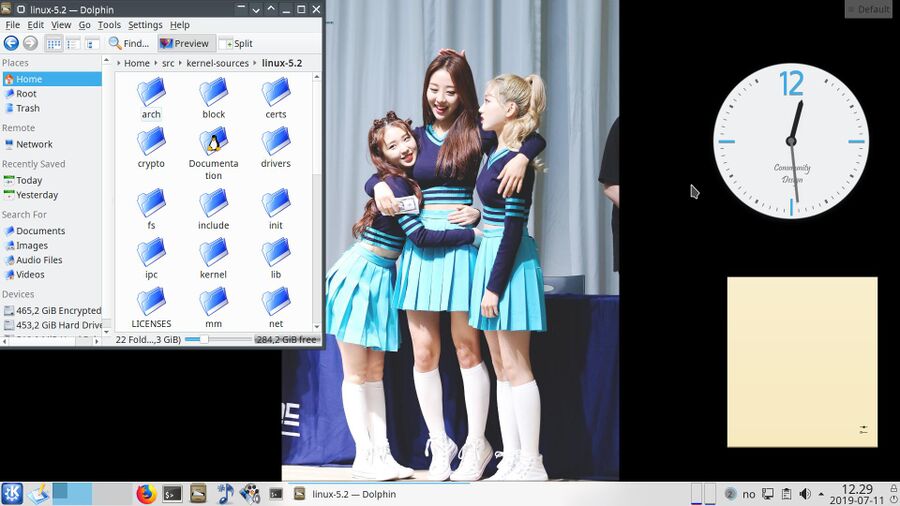KDE
KDE is a free software community organized by the German non-profit organization KDE e.V. KDE is also a commonly used name for a desktop environment the KDE e.V. themselves now refer to as "Plasma".
The Three Biggest KDE Software Projects[edit]
The KDE community releases a lot of software. The most notable and bigger products they release are:
- The KDE Plasma Desktop Environment
The KDE Plasma Desktop[edit]

The KDE Plasma desktop environment version 5.15.5.
The K Desktop Environment (KDE), now known as "Plasma", is a fully featured desktop environment built on the Qt toolkit libraries and KDE's own "KDE Frameworks" libraries. The KDE deskttop environment has been around since 1996.
- See KDE Plasma for additional information about KDE Plasma.
The KDE Frameworks[edit]
KDE applications are built on a set of special libraries built on top of the Qt toolkit. These libraries are called the "KDE Frameworks". It is essentially "Qt libraries with more functionality" or Qt functionality replaced with better and/or more advanced implementations.
The KDE Frameworks libraries make it really easy to write very advanced software in C++ with a whole lot fewer lines that you would need to write something from scratch.
One big advantage to the KDE Frameworks over that foot desktop thing's libraries is that a program written using the KDE Frameworks works perfectly in all desktop environments as long as the required libraries are installed. The KDE Framework libraries follow Freedesktop standards closely. This ensures that a program written primarily for KDE works perfectly on Xfce, fluxbox, IceWM and other environments.
- See KDE Frameworks for additional information about KDE Frameworks.
KDE Gear[edit]
The KDE project used to ship one big package called KDE with a complete desktop environment and a diverse set of applications for it. The way the KDE desktop environment is shipped has changed several times over the decades KDE has existed.
- The packages that make up the desktop environment is now shipped in a bundle called the "Plasma" desktop environment.
- The KDE stand-alone KDE libraries are shipped in a bundle called the KDE Frameworks.
- All the KDE applications made primarily for the "Plasma" desktop, mostly using the KDE Frameworks libraries, are bundled together in a huge package called "KDE Gear".
The KDE Gear is very big. There's everything from file managers to games to text editors in each KDE Gear release.
The "KDE Gear" name may be a big confusing since the software compilation now known as "KDE Gear" has formally had names like:
- "KDE" (there was initially just one package with the desktop, libraries and applications)
- "KDE Applications"
- "KDE Software Compilation"
- "Release service "
The "KDE Gear" package itself can also seem a bit confusing to end-users, but they are some good reasons why the KDE community packages hundreds of seemingly different packages together in a big bundle.
- Developers benefit because they get to be part of a big coordinated KDE release and they get a limited amount of support from the KDE "community".
- GNU/Linux distributions tend to ship the big "KDE Gear" packages in a reasonably timely fashion. That's rare the case with someone's pet project calculator or other smaller things like that.
- Getting a package into the KDE Gear increases the chance of someone else picking up the torch if the original maintainer is hit by a bus or loses interest.
Most distributions split the package with KDE Gear applications package, formally known as the "KDE Software Compilation" and the "KDE Applications", into smaller packages that can be installed individually. It is unlikely that you will encounter anything named "KDE Gear" in a GNU/Linux distributions repositories, but you will see all the individual packages like KWrite, the Kate text editor, the Dolphin file manager, the Plasma Discover application store and a ton of other applications built on the KDE Frameworks.
The KDE "Community"[edit]
KDE has something resembling a community. Most of those in it are developers, there are few people outside the narrow IT bubble involved with the project.
Many of the KDE developers, notably those working for large for-profit corporations invested in the project, get very upset if you point out bugs in their precious KDE Plasma desktop environment. This has some rather odd side-effects: They will not only silence people asking how to work around bugs in KDE software, they will also silence anyone who provides a solution to a bug in KDE software and even patches fixing bugs since workarounds and patches for known bugs are seen as an acknowledgement that the bugs do, in fact, exist in the KDE software. This can be seen on the IRC and Matrix channels controlled by KDE "leaders" all the time and it is also very common on /r/kde on Reddit and other forums controlled by corporate-owned KDE "community" leaders. The result is that a lot of kDE bugs stay around for years and years due to this rather odd and somewhat unique unofficial policy.

Enable comment auto-refresher
Anonymous (88223f64b7)
Permalink |